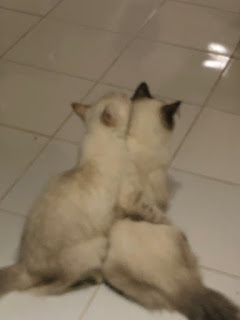 |
| Himalayan Pairs |
Welcome to the world of Himalayan cat breeds, where elegance meets affection. In this article, we'll explore the steps to form a loving and harmonious family with these majestic felines.
1. Choosing your himalayan cat
When building your Himalayan cat family, start by selecting a reputable breeder to ensure the health and well-being of your new furry family member. Consider factors such as age, gender, and temperament to find a cat that aligns with your family dynamics.
 |
| Emong and Mili |
2. Preparing your home
Create a cat-friendly environment by providing cozy bedding, scratching posts, and interactive toys. Himalayan cats appreciate a quiet and calm atmosphere, so designate a peaceful space for them to retreat to when needed.
3. Nutritions matters
A well-balanced diet is crucial for the health of your Himalayan cat. Consult your vet for recommendations on high-quality cat food that supports their specific needs, including their luxurious coat.
4. Regular Vet Check ups
Schedule regular veterinary visits to ensure your Himalayan cat's health is in top condition. Vaccinations, dental care, and preventative measures are essential for a long and happy life together.
5. Socializing Your Himalayan Cat
Himalayan cats are known for their social nature. Gradually introduce them to family members, including other pets, if applicable. Provide positive interactions and rewards to strengthen the bond between your cat and the family.
 |
| Moci (Kitten) |
6. Grooming RitualsDue to their long, luxurious fur, Himalayan cats require regular grooming to prevent matting and keep their coat shiny. Establish a grooming routine early on to make it an enjoyable experience for both you and your feline friend.
7. Playtime and Enrichment
Keep your Himalayan cat mentally stimulated with interactive play. Engage in activities like feather toys and puzzle feeders to cater to their playful instincts and prevent boredom.
8. Health Monitoring
Stay vigilant about your Himalayan cat's health. Watch for any signs of discomfort, changes in behavior, or unusual habits. Early detection of health issues can lead to prompt treatment.
9. Breeding Considerations
If you decide to expand your Himalayan cat family through breeding, it's crucial to thoroughly research and understand the responsibilities involved. Responsible breeding contributes to the overall well-being of the breed.
Forming a loving family with Himalayan cats requires dedication, patience, and a deep understanding of their unique needs. By following these guidelines, you can create a harmonious environment where your Himalayan cat can thrive, bringing joy and elegance to your home.





.jpg)

Comments